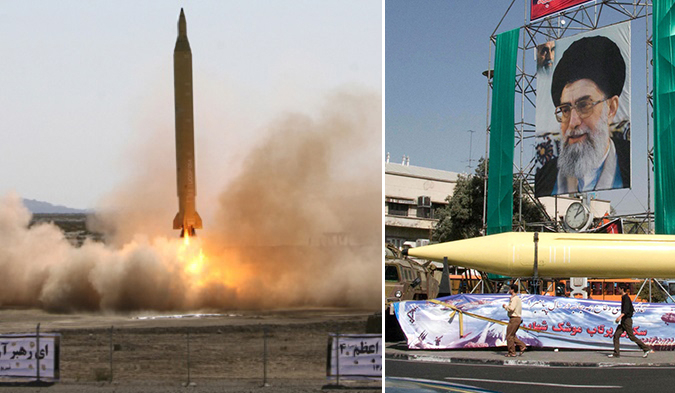The threat posed by Iran’s missile capability has become horribly clear
كون كوكلن/ناشيونال/لقد أصبحت قدرات صواريخ إيران مخيفة جداً
Con Coughlin/The National/October 05/18
Tehran’s attack on Syria was a carefully calculated show of strength and the willingness to use brutal force.
Iran wants the world to believe that the missile strikes it launched this week in eastern Syria against what it claims were terrorist targets were simply its response to last month’s attack on a military parade in Ahvaz.
While retaliating against those whom Tehran holds responsible for the worst terrorist attack on Iranian soil for nearly a decade was clearly a key factor, the response needs to be seen within the wider context of the growing sophistication of Iran’s military arsenal, with all the implications that has for the wider security concerns of the region.
According to a spokesman for the Islamic Revolutionary Guard Corps, Iran’s aerospace forces fired six short-range surface-to-surface missiles from the north-western province of Kermanshah. They flew over central Iraq and struck targets near the eastern Syrian town of Abu Kamal, near the Iraqi border at positions Iran says are held by ISIS, which it holds responsible for the Ahvaz attack that killed 24 people and wounded more than 60.
The missiles travelled a distance of 570 km (374 miles), and for good measure bore slogans reading “Death to America”, “Death to Israel” and “Death to Al Saud”. Tehran has claimed the Ahvaz attack was the work of ISIS militants, working in conjunction with Sunni Muslim Arab separatists who seek independence from Iran’s Shia-dominated clerical regime.
But, as is often the case whenever Iran initiates military action, there were also a number of other factors that informed Iran’s decision to attack that particular site at that particular moment. For a start, the site chosen for the missile strike was just three miles from where the US has around 2,200 troops based as part of its own effort to destroy ISIS.
And the timing of the attack was designed to coincide with the case Iran has brought before the International Court of Justice to protest against Washington’s decision to impose fresh sanctions, in which the court ruled in Tehran’s favour.
At a time when the Iranian regime has been under intense pressure from anti-government protests taking place throughout the country, both these actions are aimed at reassuring Iran’s sceptical domestic audience that the government remains determined to protect their interests.
Moreover, with less than a month to go before the US imposes a strict oil embargo, Iran is desperate to demonstrate that it is capable of setting its own agenda, and not allowing the US and its allies to dictate terms. There is, though, another important dimension to the missile attacks, one that has profound implications for the wider region.
With the Syrian conflict nearing its end, Iran is seeking to consolidate its position by building a corridor stretching from Iran and running through Iraq into Syria and Lebanon. The primary objective of establishing such a corridor through the Sunni Muslim heartlands is that it would represent a serious upgrade in the ability of Iran’s Shia theocracy to challenge sworn enemies in the region, such as Israel and Saudi Arabia.
The Trump administration is well aware of Iran’s strategic designs, and to this end is, with the help of Kurdish and Arab allies, seeking to prevent Tehran from achieving this goal. Consequently, this has resulted in a 12-mile stretch of the Iraq-Syria border becoming the centre of a bitter rivalry between Iranian-backed forces and US-backed forces.
The fact, therefore, that Iran decided to fire its latest salvo into Syria, so close to American positions was a deliberate signal from Tehran that it now has sophisticated missile technology to operate well beyond Iran’s borders, and that it is prepared to use it.
From an American perspective, the Iranian action can be seen as highly provocative. Unlike the Americans and Russians, who observe the protocol of forewarning other military actors in Syria’s congested airspace of imminent military action, no such prior notification was forthcoming from the Iranians.
This prompted a Pentagon official to denounce the strikes as “reckless, unsafe and escalatory”.
This latest incident needs to be seen in the context of an upsurge in provocative military action against the US as the oil embargo deadline approaches. American military compounds in Baghdad and Basra were attacked by rocket fire last month, while American warships patrolling the vital shipping routes through the Strait of Hormuz are regularly subjected to Iranian intimidation.
Iran is likely to increase the pressure on the US and its allies, particularly because it now possesses the missile technology to do so. The Iranians have already demonstrated the effectiveness of the advances they have made in developing their arsenal of ballistic missiles by supplying them to Houthi rebels in Yemen to attack targets in Saudi Arabia.
Moreover, Iran sees the deployment of these new systems as a key element in its attempts to consolidate its presence throughout the Middle East. To this end Tehran is seeking to establish a network of new missile bases in Iraq and Syria to supplement those that it has already established in Lebanon. And, if Iran is allowed to continue expanding its military presence throughout the Arab world, this could lead to a dramatic shift in the region’s balance of power.
For decades, Western intelligence agencies have been warning about the threat posed by Iran’s missile programme. Now, it appears, those warnings are becoming a grim reality.
**Con Coughlin is the Daily Telegraph’s defence and foreign affairs editor





















